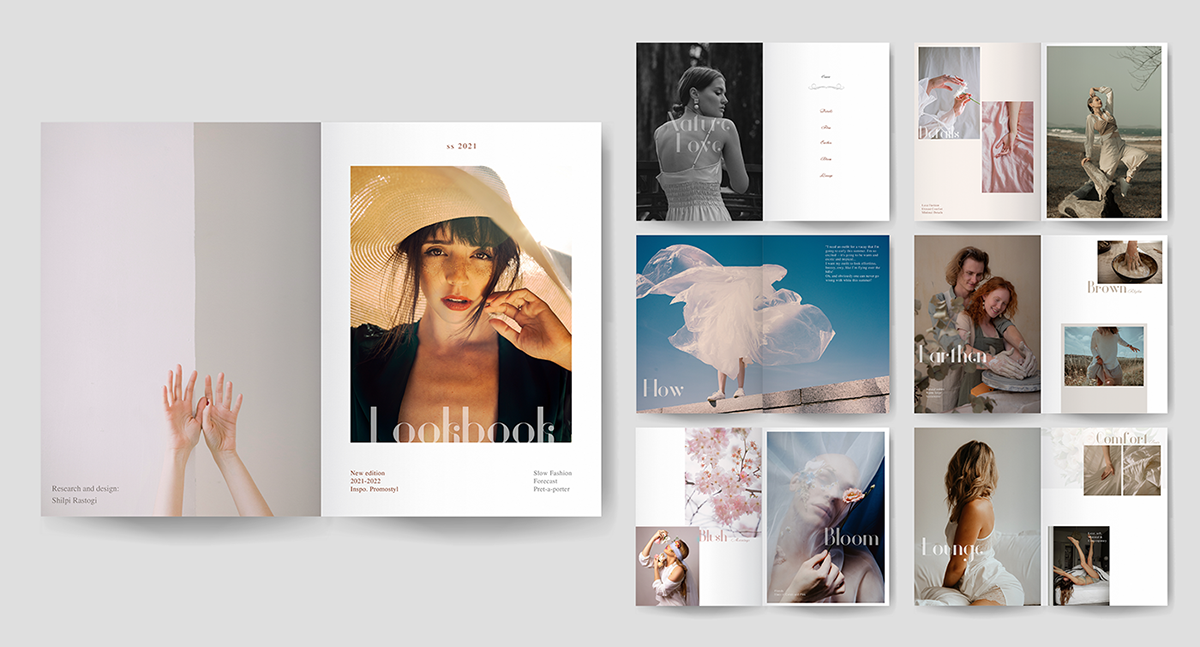Introduction
In the ever-evolving world of fashion, the lookbook has emerged as a powerful tool for brands and designers to convey their creative vision, showcase collections, and captivate audiences. A well-executed fashion lookbook goes beyond showcasing garments; it weaves a narrative, tells a story, and evokes emotions that resonate with consumers. This article delves into the art of creating compelling fashion lookbooks, exploring the elements that contribute to their success, the steps involved in their production, and the impact they have on brand identity and consumer engagement.
I. The Power of Fashion Lookbooks
Visual Storytelling: Fashion lookbooks serve as visual narratives that transport viewers into the world of a collection. They communicate the inspiration behind the designs, the mood of the collection, and the designer’s artistic intent.
Brand Identity: Lookbooks provide a platform to communicate a brand’s ethos, values, and design aesthetics. Consistency in style, color palette, and visual language reinforces brand identity and recognition.
Consumer Connection: Well-crafted lookbooks establish a connection with consumers by resonating with their aspirations, emotions, and desires. They help consumers envision how the garments fit into their lifestyles.
Marketing and Promotion: Lookbooks are valuable marketing tools used to promote new collections, generate buzz, and attract attention from fashion enthusiasts, media, and potential buyers.
II. Elements of a Captivating Fashion Lookbook
Conceptualization: A successful lookbook begins with a clear and compelling concept. This concept should align with the collection’s inspiration and message, guiding the creative direction.
Mood and Aesthetics: Establishing a consistent mood and visual aesthetics is crucial. This includes choosing the right color palette, typography, and overall design elements that reflect the collection’s theme.
Model Selection: The choice of models plays a pivotal role in conveying the target audience and the brand’s inclusive values. Models should complement the collection and embody the brand’s spirit.
Location and Set Design: The backdrop against which the garments are showcased contributes to the overall narrative. The location and set design should enhance the collection’s story and ambiance.
Styling and Accessories: Thoughtful styling, including pairing garments with accessories, creates a complete and coherent visual representation of the collection.
Photography and Composition: High-quality photography with attention to composition, lighting, and angles elevates the aesthetic appeal of the lookbook.
Narrative Flow: Organize the lookbook’s layout in a way that tells a cohesive story. The sequence of images should guide the viewer through the collection’s journey.
III. Production Process of Fashion Lookbooks
Pre-Production Planning: Define the concept, mood, and objectives of the lookbook. Determine the location, models, styling, and creative team involved.
Creative Team: Assemble a team comprising photographers, stylists, makeup artists, hairstylists, and other professionals who contribute to the lookbook’s production.
Location Scouting: Choose locations that complement the collection’s theme and enhance its visual storytelling. Consider both indoor and outdoor settings.
Styling and Wardrobe: Select garments that align with the collection’s narrative and theme. Collaborate with a stylist to create cohesive and impactful looks.
Photography and Direction: Work closely with the photographer to capture the collection’s essence. Direct the models, poses, and expressions to convey the intended emotions.
Post-Production: The editing phase involves selecting the best images, color correction, retouching, and designing the layout of the lookbook.
Distribution and Promotion: Once the lookbook is finalized, distribute it through various channels, including the brand’s website, social media, and press releases.
IV. Impact and Success Measurement
Consumer Engagement: Monitor the engagement metrics, such as likes, shares, comments, and website visits, to gauge the lookbook’s effectiveness in resonating with the audience.
Media Coverage: Positive media coverage and features indicate the lookbook’s appeal to fashion journalists, bloggers, and influencers.
Sales and Conversion: Analyze whether the lookbook contributes to an increase in sales, website traffic, and conversion rates.
Brand Perception: Assess how the lookbook influences the perception of the brand’s identity, values, and design prowess.
V. Evolving Trends in Fashion Lookbooks
Interactive and Digital Lookbooks: Embrace digital formats, including interactive websites and multimedia elements, to create immersive and engaging experiences.
Diversity and Inclusivity: Reflect diverse demographics in models, body types, and cultural backgrounds to foster inclusivity and resonate with a broader audience.
Sustainability Focus: Highlight sustainable practices and ethical production methods in the lookbook to align with evolving consumer values.
Cross-Collaborations: Collaborate with artists, photographers, and influencers to infuse fresh perspectives and creative energy into the lookbook.
Conclusion
Fashion lookbooks are more than a collection of images; they are powerful storytelling tools that bridge the gap between creativity and consumer connection. Through meticulous planning, thoughtful execution, and a focus on visual narrative, fashion brands can create captivating lookbooks that leave a lasting impression, foster brand loyalty, and contribute to the ever-evolving landscape of fashion communication. As the industry continues to evolve, embracing innovative formats and inclusive narratives will ensure that fashion lookbooks remain a relevant and impactful medium in the years to come.






